Teaching Piano: Which Method Books Should I Use?
Affiliate links included: When recommending music products for you, I sometimes use affiliate links. If you click and make a purchase, I will receive a small commission. This doesn't cost you anything and helps me continue to provide you with helpful content and music resources. (All content and opinions are my own.)
John Thompson, Alfred, Bastien, Piano Adventures -- which piano method books should you use to teach piano lessons?
I've tried A LOT of piano method books in over 15 years of teaching piano lessons, and I've come to learn what works and what doesn't. I'd like to share with you what I've learned, and hopefully I can help some other piano teachers out there as you try to figure this out for your own studio.
Choosing a Piano Method Series
Your piano method series is your main teaching tool. You'll use other music and learning materials, too, but the method books are the core of your piano education. They should mesh with your teaching philosophies, you should like the music included, and you should feel confident that they will help you transform your students into good pianists.
Most teachers will choose one main method series for their students. (I personally use several methods and will explain why later in this post.)
Before I go over how to choose a piano method series for your piano studio, let me share my own personal recommendations.
My Top Piano Methods for Teaching Piano
After a lot of trial and error, I've determined that these piano books work best for me and my students. I'll share just a few of the reasons that I like these methods best.
The Top 2 Piano Methods I Use In My Studio
John Thompson's Modern Course for the Piano
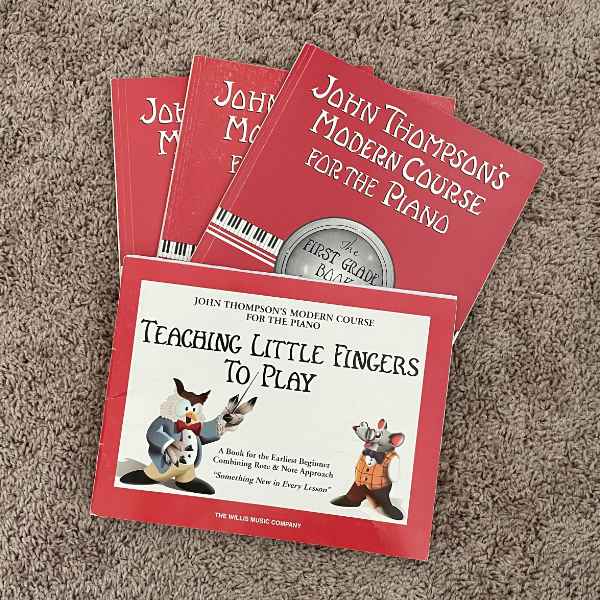
I like this method because of all the methods I've tried, it is the most consistent in producing lifelong pianists. Nearly all my best students over the years started with this method series.
Praises: The series moves at easily twice the pace of most piano methods, so students progress quickly. It teaches great fingering and develops both hands equally, with significant Left Hand involvement early on. Each book is a pretty well-rounded standalone teaching book, although I do recommend supplementing as needed. The music is beautiful and musically interesting, with many classical and folk selections.
I especially love the music in the Second Grade and Third Grade books of the series.
Criticisms: There are no jazz, rock, or modern selections, and the black-and-white artwork is outdated (although the Primer has been updated with colorful imagery). Also, some students rely too much on the finger numbers (instead of reading the notes/intervals), so I cross out unnecessary fingerings and supplement with music where they have to figure out the notes and fingering themselves.
Tips: Supplement with appropriate level theory, exercise/technique books, and modern music as desired. Make sure you reinforce note names and teach interval recognition, and cross out unnecessary finger numbers if it seems like students are relying too much on them. Consider having students transpose the pieces early on to help them recognize patterns more easily.
Best for: Students who need an accelerated approach, are great at practicing, have lots of family support, like classical and folk music, and/or who are older (though not necessarily; I have taught 4- and 5-year-olds with it). Adults and teens may be able to skip the "Teaching Little Fingers to Play" primer and begin with the First Grade book.
Check out the books yourself:
John Thompson's Modern Course for the Piano
John Thompson primer "Teaching Little Fingers to Play"
Supplementary books for Teaching Little Fingers to Play
Supplement with:
Faber and Faber Basic Piano Adventures
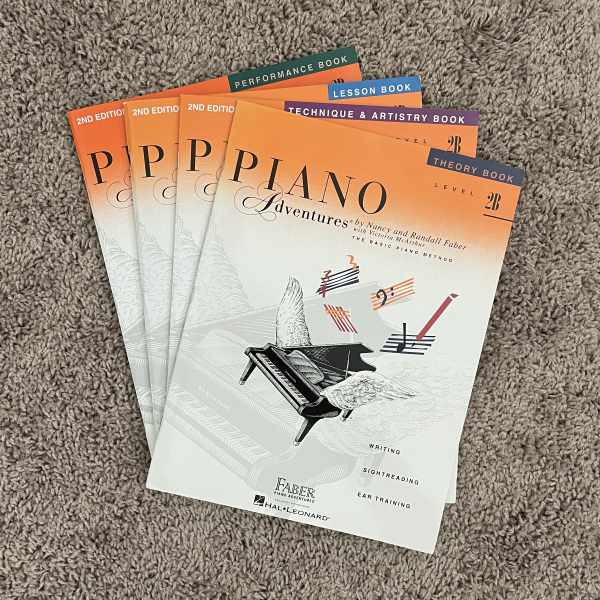
I like this method because nearly all students can succeed with it. It moves at a casual pace and offers plenty of review and reinforcement for students who need it.
Praises: Every level has appropriate and relevant theory, technique, artistry, reading, and performance music. It teaches intervallic reading, which helps many students successfully read music sooner, faster, and better than they would with note name mnemonics. The colorful artwork and more modern music (including more rock and jazz) appeal to many of today's children.
I especially love the music in the Performance books; there are wonderful selections in varied styles.
Criticisms: I dislike the Primer's approach of starting off-staff, so I start my students with an on-staff method primer (like the John W. Schaum Pre-A Green Book) and switch them over to Piano Adventures Level 1 after that. Also, some of the music is a bit boring; some pieces were clearly written just to teach a musical concept rather than to introduce aurally pleasing music. Lastly, it's often difficult to get through all 4 books every lesson. (Students also struggle to keep track of 4 books with such similar covers!)
Tips: Use all 4 books for each level (Theory, Technique and Artistry, Lesson, and Performance Book -- they really are all useful.) Students who grasp concepts quickly can easily skip ahead, or you can move them to the Accelerated Piano Adventures series.
Best for: Many of today's students (especially younger ones), as well as those who are seeking a more casual learning experience, don't practice a ton, and/or have less family involvement. This is also a good piano method for students with vision problems or reading difficulties because the print is large and the notes are spread out. It's also good for students who struggle with coordination, as it introduces two-hand playing slowly and gradually.
Check out the books yourself:
Faber Accelerated Piano Adventures for the Older Beginner
Faber My First Piano Adventure (for young beginners)
More Faber Piano Adventures Books (great for supplementing)
Supplement with:
Other Piano Methods I Like:
I also like to use the following piano method books for some students.
John W. Schaum Piano Course - Similar approach to John Thompson, but a slightly slower pace (still faster than many other piano method series). The primer favors Middle C position for a little too long, so I supplement with music that introduces other areas of the staff to prevent students from thinking "RH 1 is always on Middle C". The music in the Primer and Level 1 Book is fine; some pieces are a little boring. But the music in Level 2 (Piano Course B The Blue Book) is great, and it's a good supplemental book if you're using another method series.
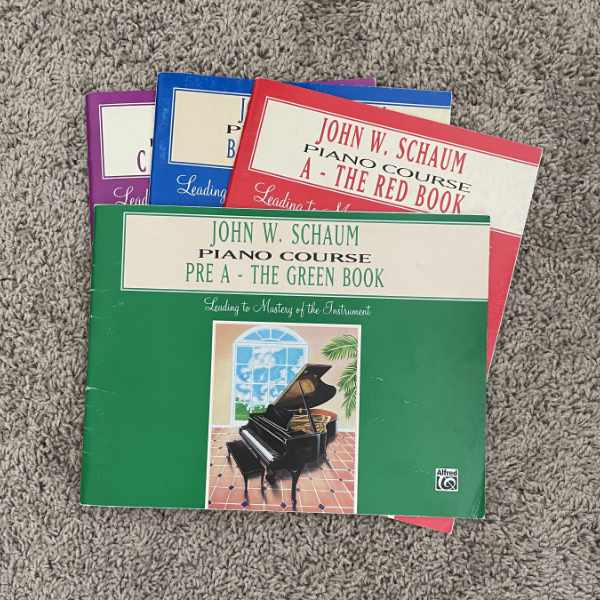
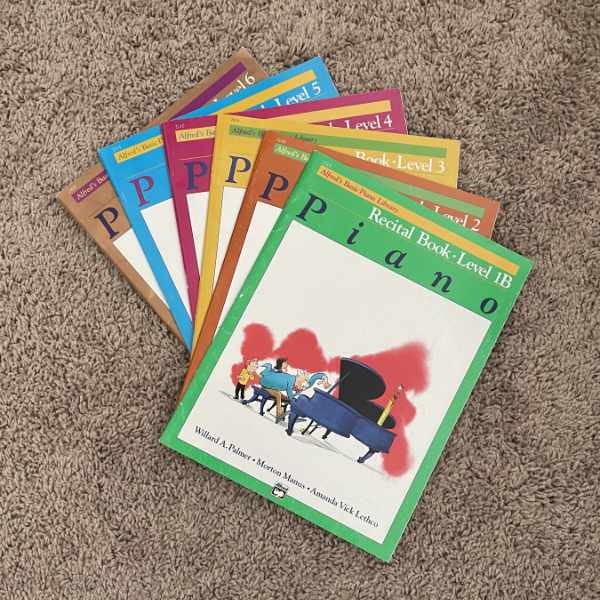
Alfred's Basic Piano Library - More jazz and blues selections than Thompson or Schaum. I like to use the Lesson Books and Recital Books as supplemental music. Recital book level 1B is great for students who need more review around Level 1-2 of Faber or Level 1 of Schaum, and the Lesson Books for level 3 and level 4 have a lot of good music. The Alfred Basic Adult All-in-One Piano Course is great for adult learners; it's a standalone book that teaches many familiar pieces and explains chords quite well.
Piano Pronto - This newer series is full of familiar classical and folk music, so I sometimes use it with students who want to learn music they know. Some students figure the pieces out by ear instead of reading the notes (I recommend supplemental reading). The early books spend too much time in C Major, and Left Hand rarely plays more than basic chord harmonies, so early supplementing is needed to strengthen bass clef reading and LH playing technique. But the familiar music is motivating; it has saved some students who probably would have quit otherwise!
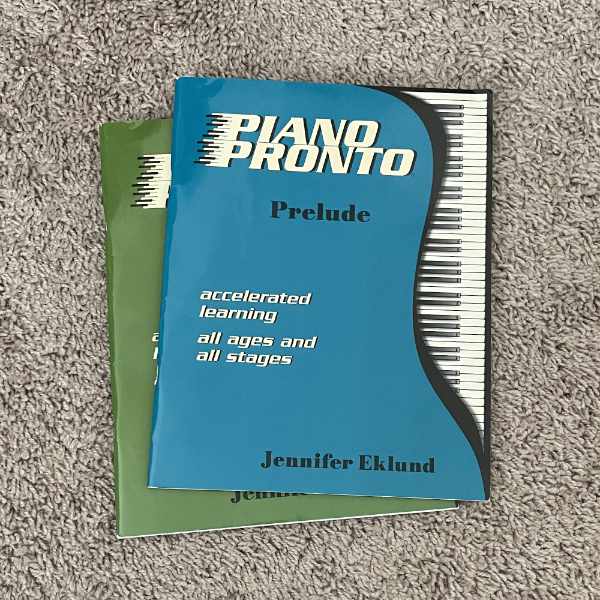
If you're interested in learning more about these piano methods, stay posted -- I'm working on a series of blogs where I review popular piano method series in detail. I'll post the links in this post when they're done so that you can easily find them.
Choosing the Best Piano Method for Your Piano Studio
Now, these piano methods work well for me and my students, but they might not be right for you. I hope you will also consider the following for your own piano studio.
Consider Your Experience
Which books did you learn from? What did you think of them? Did you like the music? Were the books easy to understand? How did you like the learning pace?
If you hated the method you learned from, don't teach from it! Chances are some of your students would also hate it, and it will be obvious to them that you hate it, which could negatively affect their opinion of piano lessons in general.
If you loved your old books, consider teaching from them. If they worked for you, they could work well for your students, too. Your students may also love the music, and it will be obvious to them that you love it, which should positively influence their learning experience.
A side note about older piano methods: Piano pedagogy has changed a lot over the years, and modern teaching philosophies are very different from older methods. But older piano methods can still be very useful! I still use John Thompson, Czerny, Alfred, and others with great success, and thousands of piano teachers continue to teach original works by Beethoven, Bach, and other great composers from hundreds of years ago.
If you are considering your old books, evaluate them with a teacher's perspective. Do you think you could effectively teach with them? The fact that you're already familiar with the methodology could be a HUGE help as you move forward with teaching while still exploring other possibilities. You may consider trial-testing them alongside a newer method (with one as the primary method and the other as supplemental material).
Consider Supplemental Books to Go With Your Method
For a well-rounded education, many piano pedagogues agree that it's best to have a main lesson book or "method book", technique or exercises, regular theory, and supplemental music.
Some series (like Faber Piano Adventures) provide all of these for you, and you can take a student pretty far before you'll need supplement. But most methods need some supplementing early on, with theory, exercises, technique, and other genres of music.
I recommend starting brand new students with at least a method book and an exercise book (such as A Dozen a Day), plus a theory book (or printable theory worksheets) and supplemental music as appropriate. I do this even for 5-year-olds. For adult students, the Alfred Basic Adult All-in-One Course can carry them pretty far as a standalone book before they will need additional books.
My Favorite Piano Method Book Supplements
Supplementary material can vary widely depending on each student's needs, but here are a few of my go-to supplemental books:
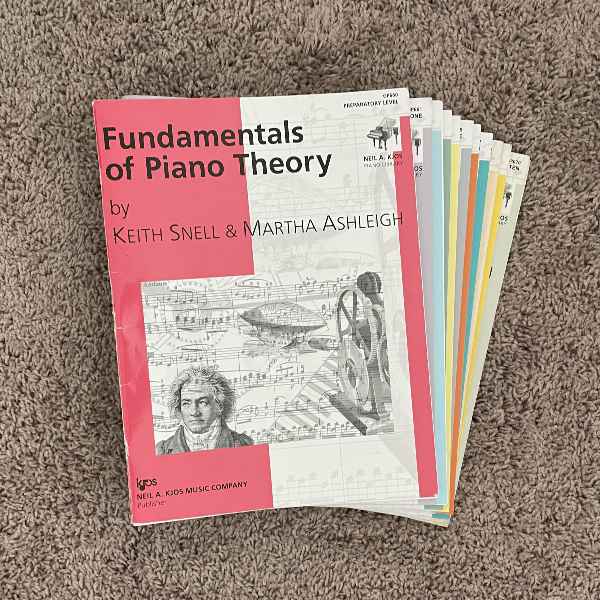
Fundamentals of Piano Theory (11 levels).
Fundamentals of Piano Theory - A graded piano theory series that teaches many musical concepts to create fantastically educated musicians. It is more of an academic approach to theory and includes worksheets, music history, sight reading, and ear training. It's also very adult friendly (not at all "childish" like may other books.)
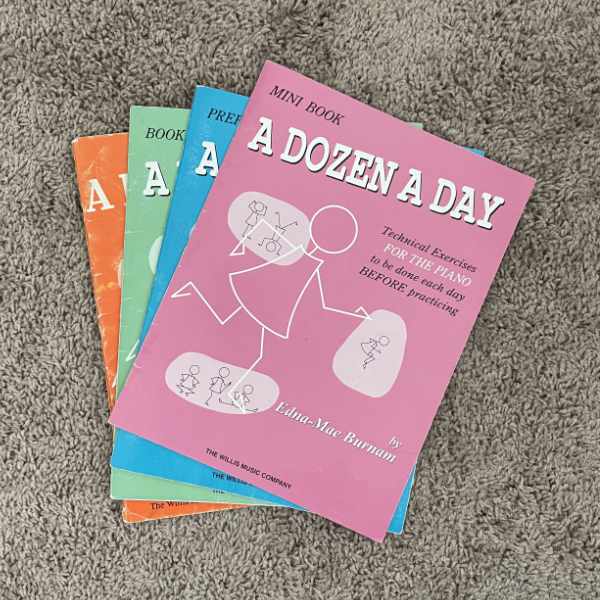
The first four Dozen a Day exercise books.
A Dozen a Day - Great exercise books for beginners. I usually start brand new students with either the Mini book or Preparatory book. Each exercise is short, each has a single new concept to learn or review, and the fun titles and stick figures help the concepts make sense in a relatable way. If you use this, encourage your students to transpose the exercises to other keys so they learn to see (and hear) patterns and intervals.
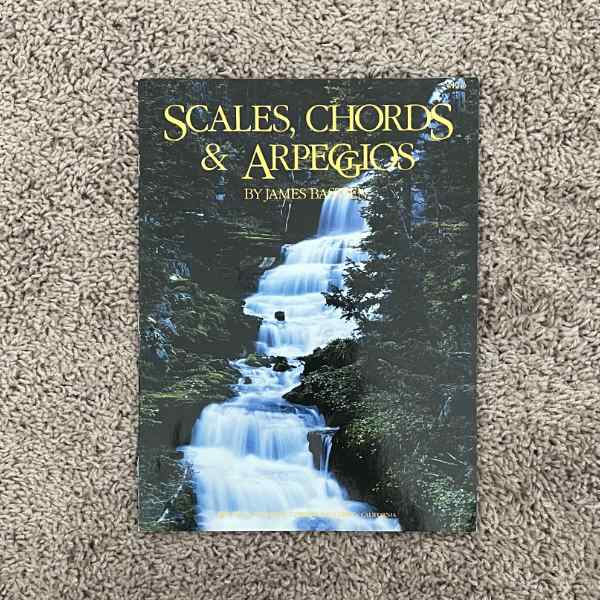
Major and H Minor scales, arpeggios, and primary chord cadences.
Scales, Chords, and Arpeggios - This book provides a clear and easy depiction of 1-octave scales, 2-octave scales, primary chords (with cadences and inversions), and 2-octave arpeggios. Includes all Major and Harmonic Minor scales as well as a Circle of Fifths and Chord Dictionary (with Major, Minor, Diminished, Augmented, and Dominant 7th chords).
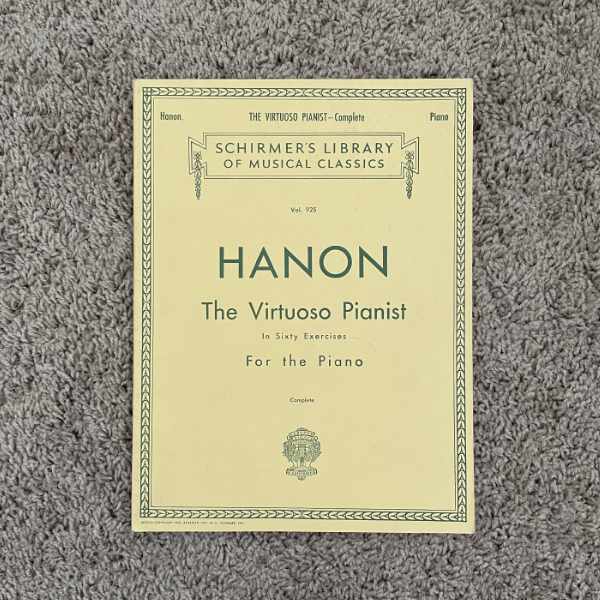
Pictured is the Schirmer edition, but I recommend using the Alfred published comb-bound edition, edited by Allan Small. (link)
Hanon: The Virtuoso Pianist in 60 Exercises - This book is excellent for two-hand coordination and technique. A good eye and ear for patterns really helps. Hanon is not for everyone; some find it boring and some do not know how to use it properly. Hanon exercises should only be taught with good technique and form (poor form can be detrimental). If taught well and used properly, this single exercise book could carry a student from elementary to advanced level.
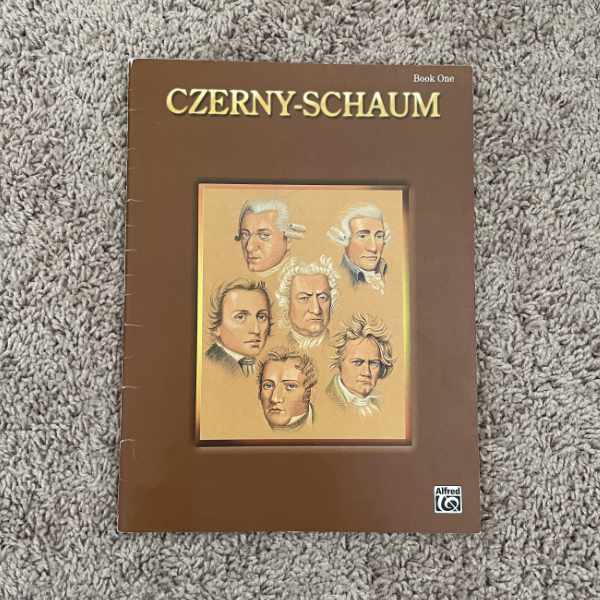
Schaum adaptations of Czerny exercises, compiled from various Czerny collections.
Czerny - Czerny wrote lots of musical exercises for every level that can help build fantastic playing skills. Each exercise is short and musical. I sometimes put students in Czerny-Schaum around level 2 instead of A Dozen a Day Book 2. I have also had good success putting some students right into original Czerny collections like Op. 139.
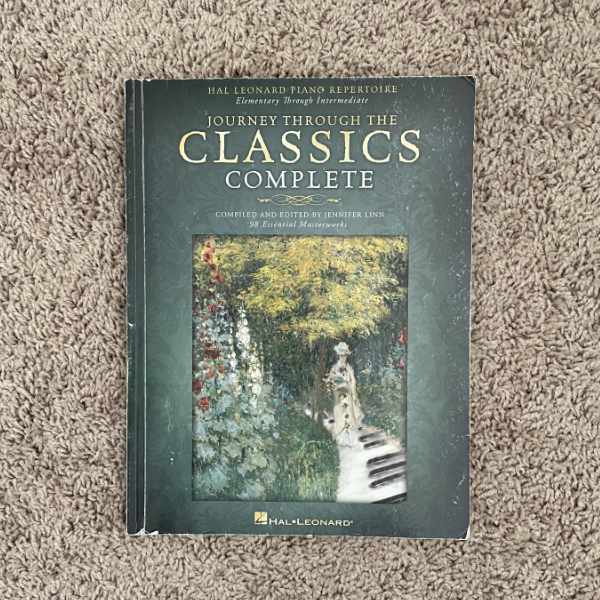
A beginner through intermediate collection of original classical piano pieces.
Journey Through the Classics: Complete - A fantastic collection of graded original classical music for elementary through intermediate level. Students build their skills page by page all the way up to Für Elise (the final piece). If desired, this could be used a method book for classical music lovers, but supplementing with theory and exercises is recommended, and new pianists should first start with an easier book (the earliest pieces are too difficult for brand-new pianists).
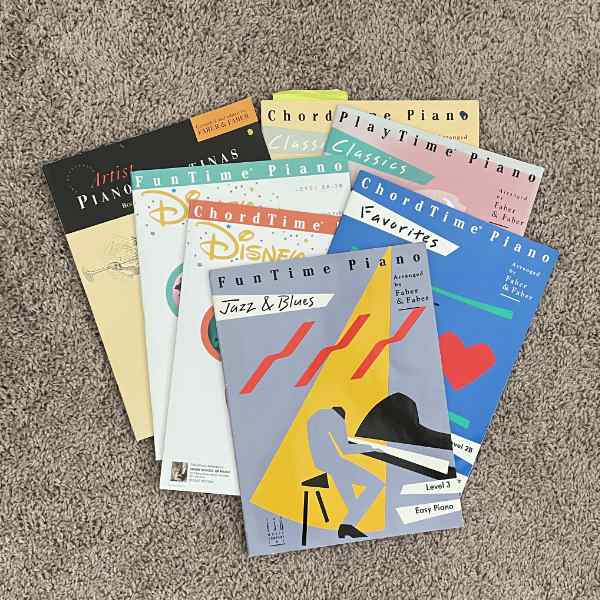
Some of the Faber supplemental piano books.
Faber Piano Adventures Supplemental books - There is a HUGE variety of supplemental books for each level of the Piano Adventures series. These are great for reinforcing reading and other musical concepts, and they give students a chance to play familiar music written for their playing level. (Their Disney books are especially popular with my students.)
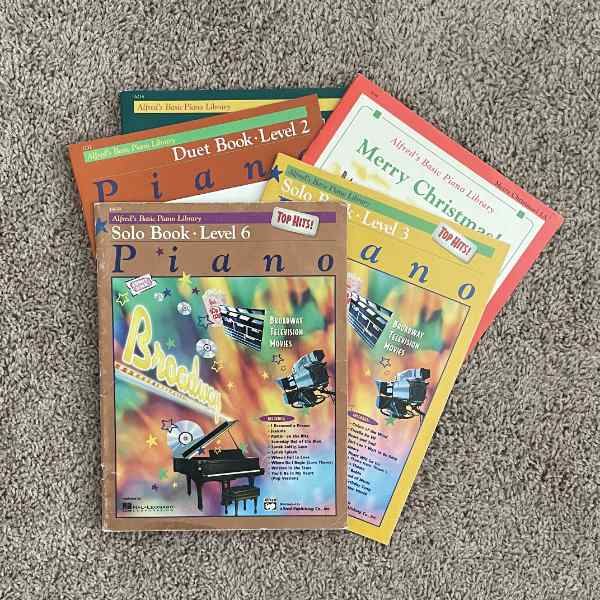
Some of the Alfred supplemental piano books.
Alfred Basic Supplemental books - There is also a great variety of supplemental books for each level of the Alfred series. These are great for reinforcing reading and other musical concepts, and they give students a chance to play familiar music written for their playing level. (Their Solo Broadway and Christmas books are especially popular with my students.)
Consider Your Students
No two students are the same, so get to know your students. Who are they?
I would use different methods based on the answers to these questions. A 5-year-old student needs a different method book than an adult. A student who practices 1 hour per day needs a different method than a student who rarely practices at all. Students who are just looking to have fun need a more casual approach than students who want to become professional pianists one day.
This is why I use several methods in my studio! My current students are all in one of 4 or 5 different method series. I have many students who are thriving in the method they're using, but I know they would really struggle (or get bored or quit) if I forced them all to learn from the same method.
Consider Your Teaching Philosophy and Goals
What are your teaching goals? Enroll everyone in competitions and recitals every other month? Give them a lifelong love of music regardless of whether they stick with it? Transform every student into a concert pianist? Keep music education casual and fun? Will you teach beginners only? Adults only? Different methods cater to different teaching styles.
Also, the various piano methods present musical concepts in different ways and orders. How do you want the information presented? At what point do you want your students to learn X, Y, and Z?
For example, look at how John Thompson and Faber Piano Adventures differ on two musical concepts:
Here are some other teaching philosophies and how they differ across a variety of popular piano method series:
Introduction to Music Reading:
On-Staff vs. Off-Staff "Pre-Reading"
On-Staff Reading:
Some method books start students reading on the music staff right away (Treble, Bass, and/or Grand Staff).
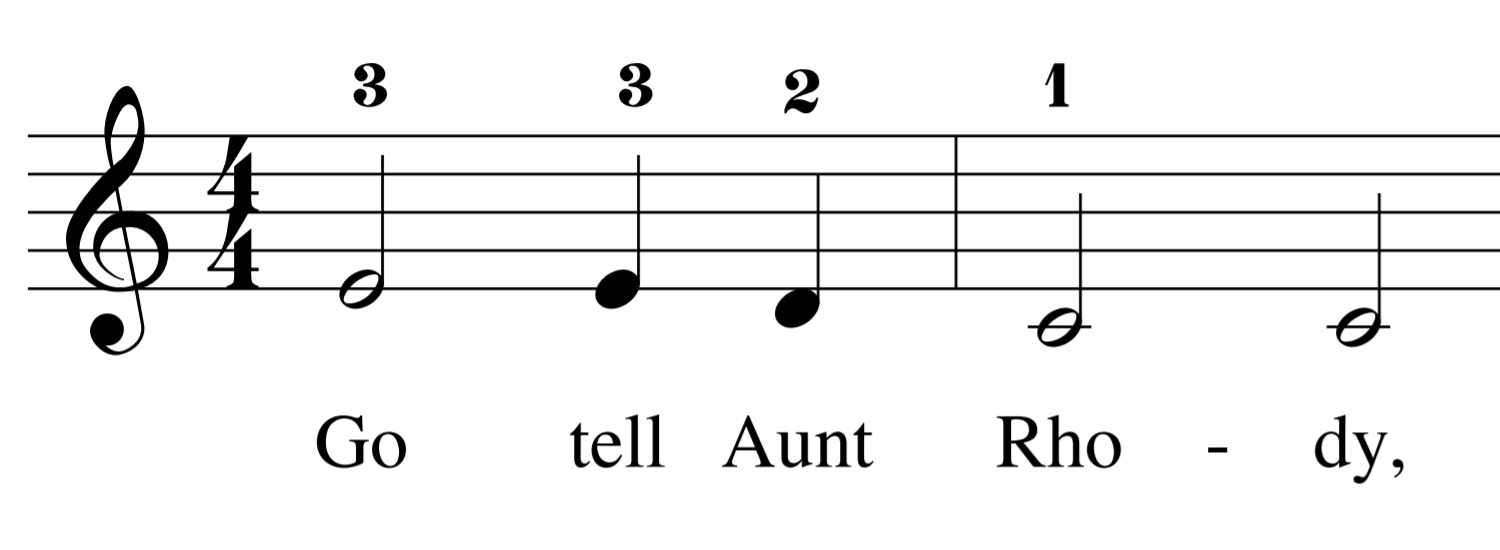
Primer level reading on-staff
Pros - Students learn to read notes on the staff right away and can be taught which piano key matches each staff line or space from the start.
Cons - Students may become overwhelmed trying to remember note values, note names, and staff lines and spaces all at once. Some concepts may need heavy supplementing early on to ensure nothing falls through the cracks.
Popular Methods that start the primer reading on staff right away:
Pre-Reading (Off-Staff):
Some method books start students with "pre-reading" (off-staff), where the notes are floating on the page.
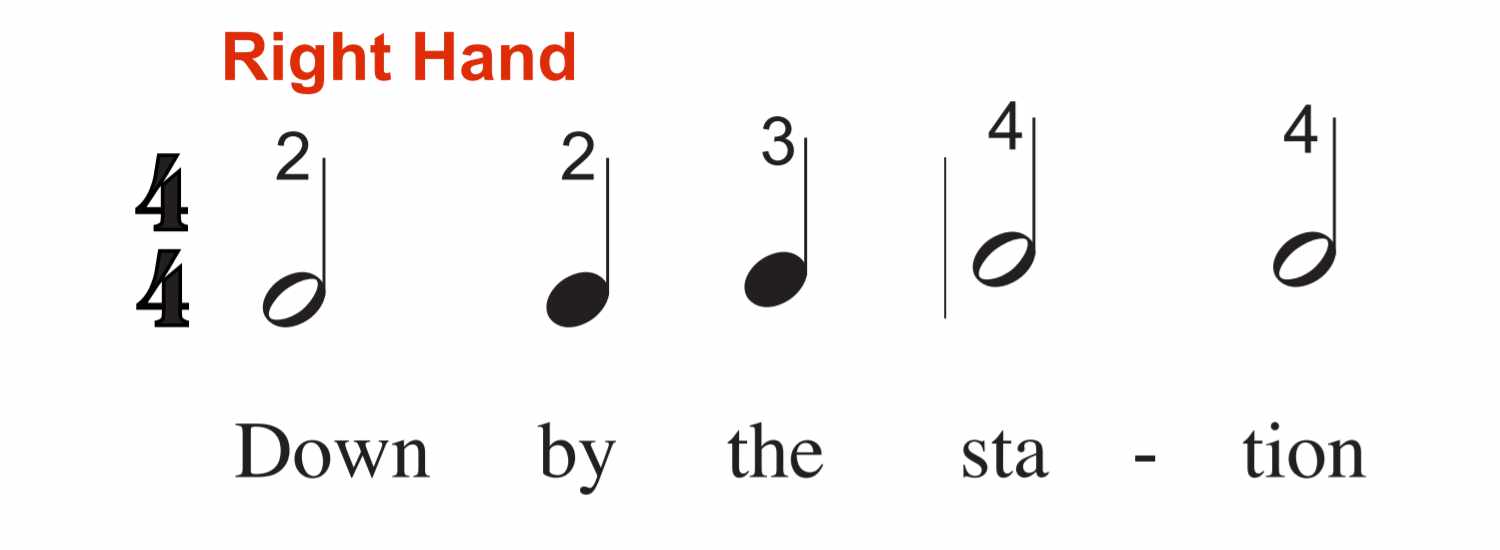
Primer level pre-reading (off-staff)
Pros - Students learn basic note values/rhythm, keyboard awareness, and finger numbers first without having to also read staff lines.
Cons - When staff lines are eventually introduced, learning the note names on the staff can be confusing. For some students, the change is so overwhelming that the teacher basically has to start all over again.
Popular Methods that start the primer with pre-reading off the staff:
Hand Positions vs. Moving Around
Hand Positions:
Some method books start with a "positional" approach, where the student's hands remain in the same general area of the piano keyboard for most or all of each piece. (These methods usually progress to moving around more by book 2 or 3.)
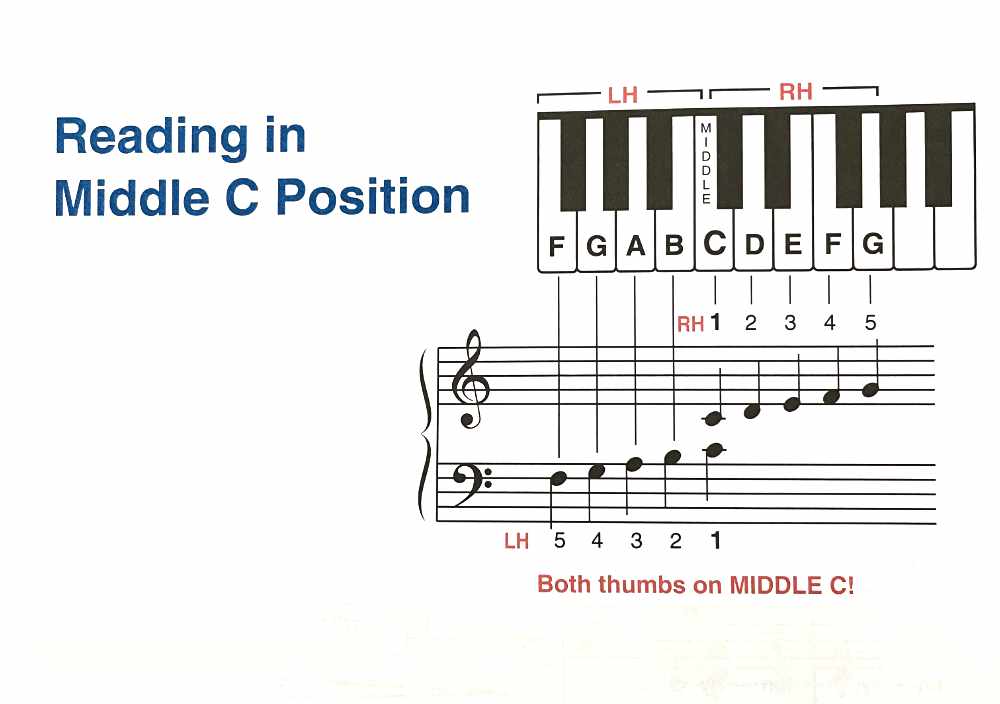
Hand remain in "Middle C Position" for the whole piece
Pros - Students become very familiar reading certain notes on the staff and usually learn them well. They can often understand steps, skips, and relationships between notes on the staff and are often better prepared to transpose written music. Those who struggle to remember note names can play with confidence if they know their hand position, which can provide essential motivation to push through learning challenges.
Cons - Students may develop a dependence on finger numbers, struggle to recognize individual note names, and not listen as carefully while they're playing. They may need extra guidance when their music requires more hand movement.
Popular Methods that favor hand positions:
Moving Around:
Some method books have the student's hands moving all around the full piano keyboard right away, rather than staying in one place.
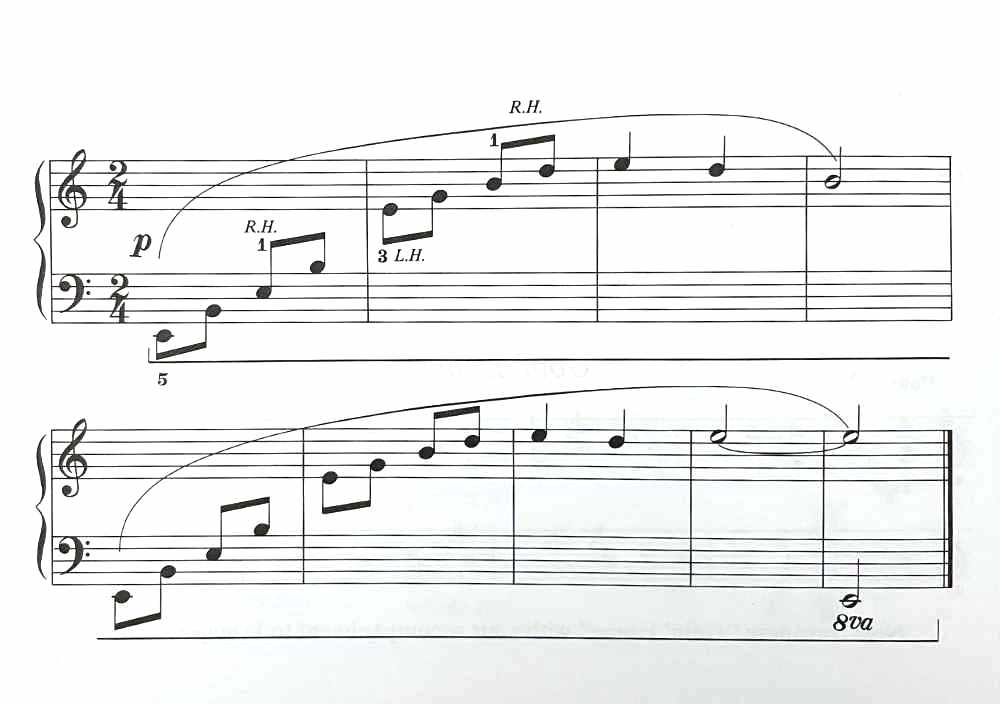
Frequent hand movement, no fixed hand position
Pros - Students become very familiar with keyboard geography and are comfortable with hand movement. They may develop aural recognition of different octaves more quickly as they explore the full range of the piano keyboard, and their music may be more "full" or aurally rewarding early on.
Cons - Students may struggle to recognize individual notes on staff and may not see intervals or relationships between staff notes as easily. They may also learn to rely heavily on rote or aural learning, rather than reading the music themselves, due to the challenges of simultaneously trying to keep track of both reading the staff AND moving to the correct keys.
Popular Methods that move around the keys more:
Finger Numbers vs. Note Names
Both of these concepts are very important for new pianists! Unfortunately, most method books struggle to properly introduce them simultaneously. Whichever method books you choose, you will probably have to work hard to make sure that your students understand and value both concepts.
Finger Numbers
Some method books teach finger numbers right away, along with note recognition.

Finger numbers on many notes, with no note names.
Pros - Students learn their finger numbers right away, learn to use all 5 of their fingers, and are taught good fingering habits from the beginning.
Cons - Students who mix up Left and Right often struggle with finger numbers. If finger numbers are overused and the book stays in one position too long, students may develop a dependence on the finger numbers and struggle to recognize note names (example: Teacher asks, "What is that note?" and student responds with "1" instead of "C").
Methods that prioritize Finger Numbers in the early books:
Note Names
Some method books start teaching note names first (with minimal fingerings) and focus on fingering techniques later.

Note names on many note heads, with no finger numbers.
Pros - Students learn their note names first, which helps them to become good note readers.
Cons - Students may not use all their fingers right away and can develop bad fingering habits if not corrected. They may avoid using certain fingers, and they may take longer to learn their music because they change which fingers they're using every time they play it. As their music becomes more technically difficult, they will not know how to figure out good fingerings for themselves and may not think it matters whether they follow the provided finger numbers.
Methods that prioritize Note Names in the early books:
Because most method series struggle to present both these concepts in an optimal way, supplementing is strongly recommended. If you prioritize Finger Numbers, supplement with note name review so that your students learn to read music properly. If you prioritize Note Names, supplement with fingering techniques and exercises so that your students learn to use their piano fingers properly.
Accelerated or Normal/Casual Pace
Accelerated
Some method books take an accelerated approach, where almost every page introduces a new concept or introduces multiple concepts at once. (Some may review concepts later.)
Pros - Students learn more quickly. Usually recommended for teen/adult students and students who practice well and frequently.
Cons - Some students will struggle to keep up and may become discouraged, or they may fail to understand concepts the first time and become confused when seeing them again in later music.
Methods that move at an accelerated pace:
Normal/Casual Pace
Some method books focus on teaching one new concept only for several pages, with plenty of review, before introducing a new concept.
Pros - Students are given more time to reinforce understanding of musical concepts before moving on, making them better ingrained in their long-term memory. Usually recommended for younger students, those who do not practice as much, or those whose family members may not be able to help them at home.
Cons - Students may progress slowly and may struggle to see their own progress, which can be discouraging. Repetition of concepts from week to week may make the learning process "boring".
Methods that move at a more casual pace:
A few other thoughts you may want to consider --
Every Piano Method Has Flaws
I hope you find a piano method that you love and that will fit the needs of your students. But remember, NO PIANO METHOD IS PERFECT.
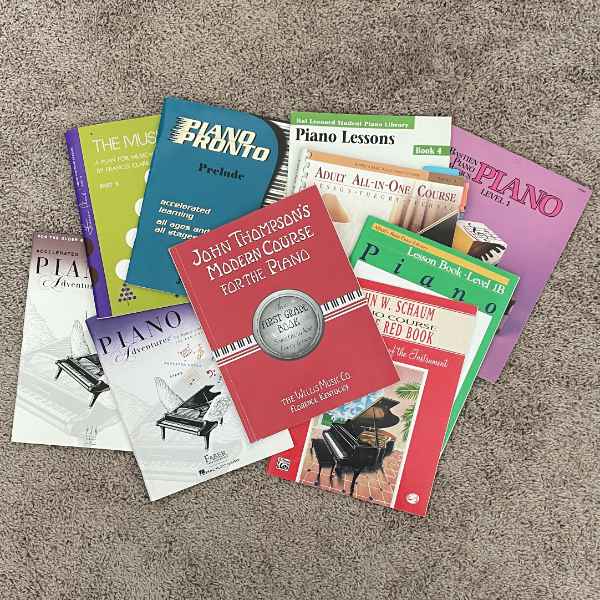
Every method has some problems that need to be addressed to help your students succeed. There are things I dislike about even my favorite methods, so I supplement to make up for those flaws (and sometimes skip pages). No matter which method series you choose, you should plan to supplement to fill in those gaps and make sure your students learn everything you want them to learn.
Be Willing to Adapt Your Teaching Approach
If you're just starting out, or if you've always used the same method series, learn to be flexible. Start with one or two teaching methods you like, supplement where necessary, and as you come across students who need a different approach, seek that out.
You may find that the student who was bored by Faber Piano Adventures absolutely LOVES John Thompson and starts practicing an hour every day. Or you may find that the student who almost quit in the middle of John Schaum Piano Course A thrives in Piano Pronto Prelude and decides to continue piano lessons for years.
Especially for beginners, be adaptive. You may start a student in one book, realize it isn't working, and need to switch them to a different method series. Or you may start teaching a concept that they just DO NOT understand, and you have to skip it and go back to it later. That's okay!
Over time, your teaching experience will teach YOU a lot, and your opinions will change, and your teaching philosophy will grow. You may even "outgrow" your favorite method series and permanently set it aside in favor of another method (or several!).
"The Teacher is the Method"
Remember this wise educational adage: the teacher is the method, not the book. Yes, the method books matters. It matters a lot! But how you use the learning material to teach your students really makes all the difference.
I promise to update this post with any new insights I have over time. I know I haven't tried every piano method out there, and if I fall in love with something new I'll be sure to update you!
Best of luck as you choose a piano method for teaching piano lessons! If you have any questions about piano methods or about teaching piano in general, please feel free to comment below or contact me here.

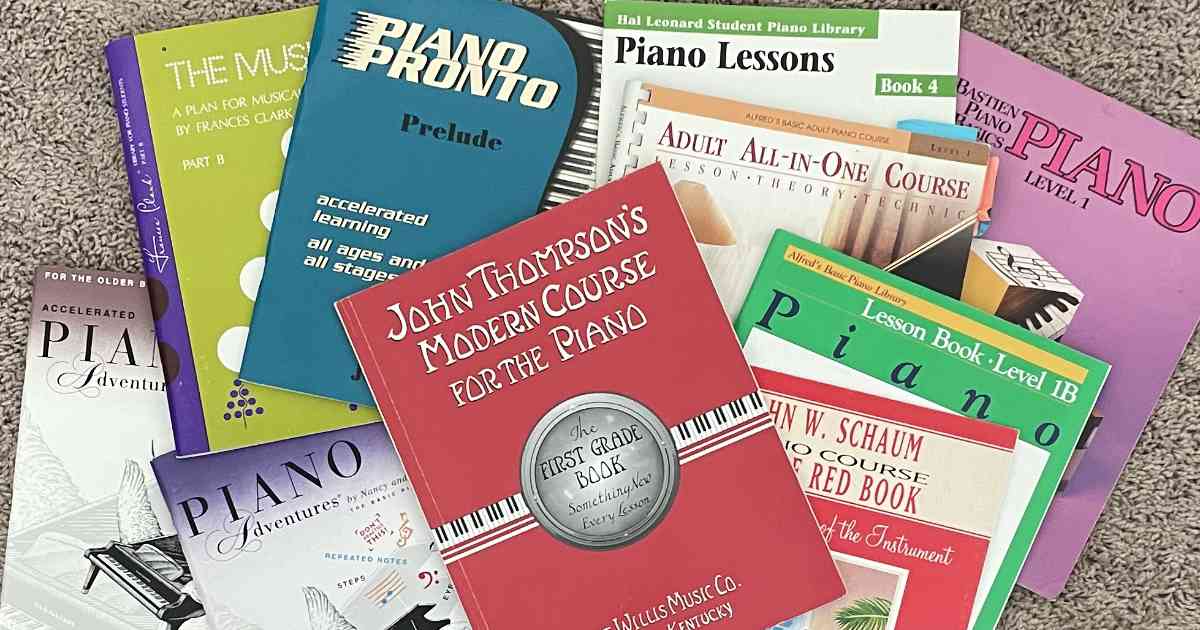
Hi, I have been teaching for 30 years and agree with you about these methods. You did not mention 2 of my favorite’s: Music for little Mozarts is fabulous for beginners (off staff) and has books 1-4. Also, is the All in one series which starts off staff and goes through 5 levels. I like it because it combines theory is you don’t need a separate theory book. It’s easier top get the kids to do because do any of them really love to fill out their theory books?
Thank you for your comment! I have not used either of those two, but I’ve certainly heard of them. I hear they’re well-liked, so I’m glad you brought them up. It’s always great to hear another teacher’s perspective and experience.
Thank you for your input, enjoyed the read and agree that the teacher is the method fully 🙂
Thank you for commenting!